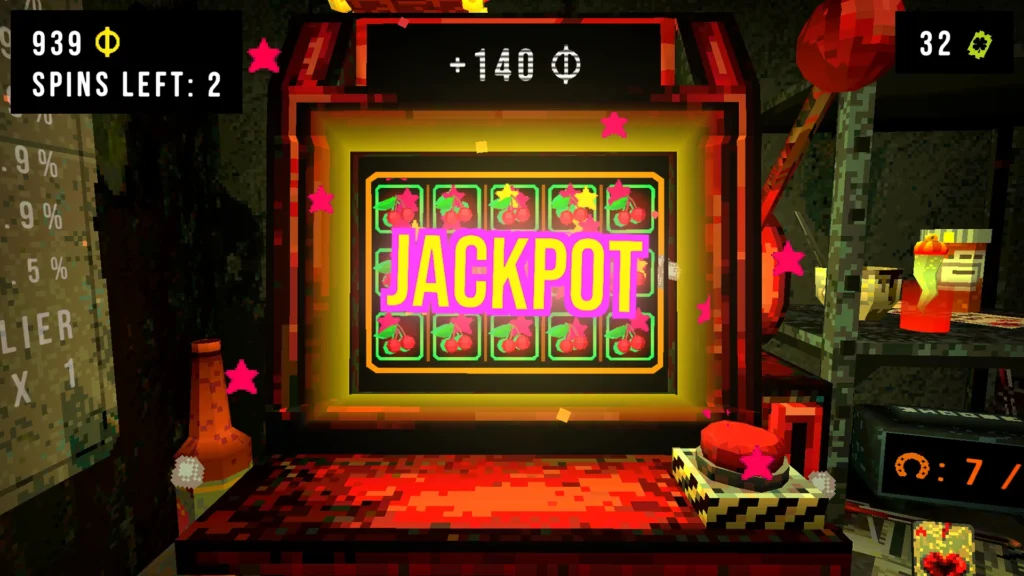There’s a special kind of tension when every pull of a lever could decide your fate. In CloverPit, developer Panik Arcade leverages that tension to create the entire experience. This isn’t Vegas glitz or casino comfort—this is survival horror wrapped around a slot machine, a rogue-lite where the jackpot might save you… or bury you deeper in debt. Released September 26, 2025, and published by Future Friends Games, CloverPit. And after countless runs, rage quits, and desperate attempts at freedom, it’s easy to see why this hellish hybrid of luck and strategy feels like both punishment and compulsion in equal measure.
A Slot Machine Straight from Hell
The setup is simple but sinister. You’re locked in a rusty cell, surrounded by peeling paint and bad vibes, with only a slot machine and an ATM to keep you company. But this isn’t your casino vacation. At the end of each round, you have a debt to pay. Fail to cough up the coins, and the floor literally gives way beneath you. It’s a nightmare loop: spin, scramble, pay up—or drop.
The tension comes from the debt mechanic. Each round, the amount you owe grows nastier, demanding better combos, stronger synergies, and riskier plays. The slot machine isn’t just chance—it’s a puzzle waiting to be bent, broken, and abused for maximum payout. Pulling the lever feels less like gambling and more like defusing a bomb.

Strategy Meets Addiction
In real life, slot machines are designed to bleed you dry. CloverPit flips that idea by encouraging you to break its system-wide open. You start with basic spins, but soon unlock charms, prizes, and modifiers that drastically change how symbols interact. Maybe cherries explode into multipliers. Perhaps skulls contribute to a combination that triples your payout. Maybe you find that one cursed trinket that snowballs into a jackpot capable of clearing an impossible round.
With over 150 items and synergies, the thrill comes from experimentation. Much like Balatro or Luck Be a Landlord, runs begin small and unassuming, then spiral into chaos as you stack modifiers into absurd builds. Suddenly, you’re not just playing slots—you’re orchestrating a Rube Goldberg machine of probability, trying to stretch your luck just far enough to meet the next payment.
The best part? When everything falls into place, it feels incredible. Watching a line hit explode into cascading payouts is pure dopamine. But when it doesn’t? Prepare to scream, restart, and tell yourself, “just one more run.”
Rogue-Lite Progression
Of course, being a rogue-lite, failure is expected. CloverPit softens the sting with meta-progression. Seeded runs, unlockable run modifiers, and permanent upgrades ensure that each failure feeds into the next attempt. You’re not just gambling; you’re learning how to bend the machine’s rules a little more each time.
The inclusion of Endless Mode is a nice touch, letting players push their luck and scores as far as possible. It leans into that compulsive “number goes up” itch, while still demanding tactical thinking. It’s not about getting lucky once—it’s about building a run so resilient that even CloverPit’s escalating cruelty can’t collapse it.
A Hellish Escape Room
What sells the concept is the atmosphere. CloverPit oozes unease. The setting isn’t glamorous or flashy—it’s grimy, oppressive, and claustrophobic. The slot machine isn’t fun; it’s a prison guard. The ATM doesn’t cheer you on; it sneers with hunger. Every element is designed to remind you that you’re trapped in a cycle of debt and desperation.
Players have compared the vibe to Buckshot Roulette, Inscryption, and even the nihilistic tension of Kaiji. It’s not horror in the traditional jump-scare sense, but in the existential dread of addiction and inevitability. The walls close in, your heart races, and the spinning reels feel more like shackles than symbols.
“CloverPit is a twisted mix of strategy and luck that keeps you on the edge of your seat. A unique and addictively challenging indie experience for those who enjoy a bit of a gamble.”
Accessibility and Replayability
CloverPit isn’t about flashy graphics or complex controls. Its design is lean, letting the mechanics and atmosphere carry the weight. The game runs smoothly—even on handhelds like Steam Deck—making it easy to get lost in “just one more run” anywhere, anytime.
The accessibility lies in its simplicity. Pull the lever. Manage debt. Build synergies. The depth comes from how far you can push the system before it snaps back and swallows you whole.
And because no two runs ever unfold the same way, replayability is through the roof. Each attempt reveals new items, new strategies, and new ways to die a horrible death. It’s a cycle players can’t resist—even when it hurts.
Not Gambling, But It Feels Like It
The developers are quick to emphasize: this is not a gambling simulator. CloverPit never asks for real money, and the slot machine is built to be manipulated and eventually overcome. But that doesn’t mean it doesn’t feel like gambling. The rush of big payouts, the despair of a busted spin, the compulsion to try again—it nails the psychology of risk without crossing into exploitative territory.
Instead, CloverPit takes the language of gambling and twists it into a narrative about debt, addiction, and escape. The slot machine isn’t entertainment—it’s a prison you have to outsmart.
CloverPit: CloverPit is brutal, brilliant, and dangerously addictive. It takes a mechanic most people dismiss as pure chance and transforms it into a tense, tactical rogue-lite. Every spin is a gamble, every run a story of desperation, and every victory a hard-fought act of defiance against a system designed to crush you. It’s not perfect—sometimes the randomness feels cruel, sometimes the escalating debts feel impossible. But that’s the point. CloverPit doesn’t want you to win easily. It wants you to fight, claw, and cheat your way through. And in doing so, it delivers one of the most unique and unsettling indie experiences of 2025. – Obsidian